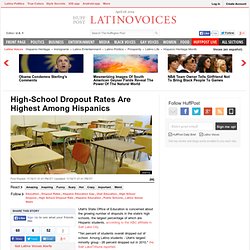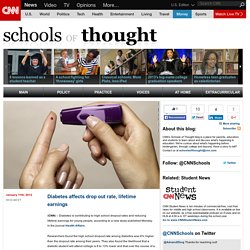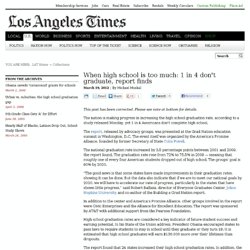

High-School Dropout Rates Are Highest Among Hispanics. Utah's State Office of Education is concerned about the growing number of dropouts in the state's high schools, the largest percentage of which are Hispanic students, according to the ABC affiliate in Salt Lake City.

"Ten percent of students overall dropped out of school. Among Latino students - Utah's largest minority group - 26 percent dropped out in 2010," the Salt LakeTribune reported. But Utah is not alone. The spike in the number of Hispanic high school dropouts is part of a national trend. "The size of the Latino student population, whose graduation rate currently lags 21 percentage points behind that of non-Hispanic whites, has grown by 50 percent in the past decade alone," according to the Education Week. High school drop out rates tend to be higher in cities with high socioeconomic disparities and racial segregation. New York is followed by Los Angeles, Cal.; Clark County, Nev., which includes Las Vegas; Chicago, Ill., and Miami-Dade County, Fla. Drug Abuse More Common Among Dropouts, Study Finds : Youth: Teen-agers who quit school also report much higher rates of criminal activity. Findings highlight need for intervention at an earlier age, officials say.
Shedding light on the web of troubles that ensnare youths who quit school, a new statewide survey shows that teen-age dropouts abuse drugs and alcohol and engage in criminal activities at dramatically higher rates than students who stay in school.

Dropouts were three times more likely to use methamphetamines, five times more likely to use cocaine or crack, and twice as likely to use LSD than their in-school counterparts. They reported weekly alcohol use rates twice as high as that of students--with beer the leading intoxicant--and were more likely to drive while drunk. Dropouts also ranked higher than students on a wide range of other problem behaviors, such as involvement in fights, selling or dealing drugs and committing a crime to obtain drugs. "We hope people will focus on how serious the dropout problem is and what the ramifications are," said state Supt. of Public Instruction Delaine Eastin.
The survey results were based on responses from 1,243 dropouts from 20 communities statewide. Study Finds High Rate of Imprisonment Among Dropouts. Effects of Poverty, Hunger, and Homelessness on Children and Youth. Behind the Scenes: Poverty, gangs plague some L.A. students - CNN.com. How U.S. graduation rates compare with the rest of the world. Twenty-five percent of Americans that start high school do not graduate.

Entering the workforce without a high school diploma means an unemployment rate three-and-a-half times the rate of those with a college degree. And for those who do find full-time work, they on average earn less than half of what a college graduate makes each year. Thirty percent of high school graduates do not go on to college right after graduation.
ADHD teens more likely to drop out. Diabetes affects drop out rate, lifetime earnings. (CNN) – Diabetes is contributing to high school dropout rates and reducing lifetime earnings for young people, according to a new study published Monday in the journal Health Affairs.

Researchers found the high school dropout rate among diabetics was 6% higher than the dropout rate among their peers. They also found the likelihood that a diabetic student will attend college is 8 to 13% lower and that over the course of a lifetime, a diabetic could lose more than $160,000 in wages. About 15,000 people were followed during the 14-year study. Seven to 12-year old students were first surveyed in the mid-1990s. They were then surveyed three more times: 1 year later, 7 years later and the last time in 2008, when they were approaching age 30. Latino High School Dropout Rate Called Critical. Latino students are dropping out of high school at such high rates that it has become a statewide crisis, speakers told an Anaheim meeting of about 800 Southern California parents, teachers and school administrators on Thursday.

Juan Hurtado, an equal rights official of San Diego State University, which sponsored the conference, said, "Throughout the state, the dropout rate of Chicano students is about 45% to 50% before high school graduation. In some schools, the dropout rate by these students is as high as 70%. We cannot wait any longer to address the problem. It has become a crisis. " But during a series of workshops and discussions at the Grand Hotel Thursday, the speakers and participants generally acknowledged that no quick, single remedy would solve the dropout problem. Opinion Divided "There is no consensus on what needs to be done first," said Lola Acosta, of the state Assembly's Office of Research. Early Childhood Roots Cited.
1 in 4 students drop out of high school, report finds. This post has been corrected.

Please see note at bottom for details. High school dropout rate climbs to 34.9% The high school dropout rate improved slightly in California last year but rose in Los Angeles, where more than one-third of students are officially classified as dropouts, state officials said Tuesday.

Statewide, 68.3% of students graduated and 20.1% dropped out, according to data released by the state Department of Education. For the Los Angeles Unified School District, the dropout rate was 34.9%. Although the state dropout rate was down 1 percentage point from the previous year, the Los Angeles Unified rate was up by more than 3 percentage points. The dropout rate is an estimate of how many students began ninth grade four years earlier and failed to graduate last spring. Nearly Half of Blacks, Latinos Drop Out, School Study Shows. Nearly half of the Latino and African American students who should have graduated from California high schools in 2002 failed to complete their education, according to a Harvard University report released Wednesday.

In the Los Angeles Unified School District, the situation was even worse, with just 39% of Latinos and 47% of African Americans graduating, compared with 67% of whites and 77% of Asians. The report concluded that the public remains largely unaware of the true extent of the problem because the state uses "misleading and inaccurate" methods to report dropout and graduation rates.